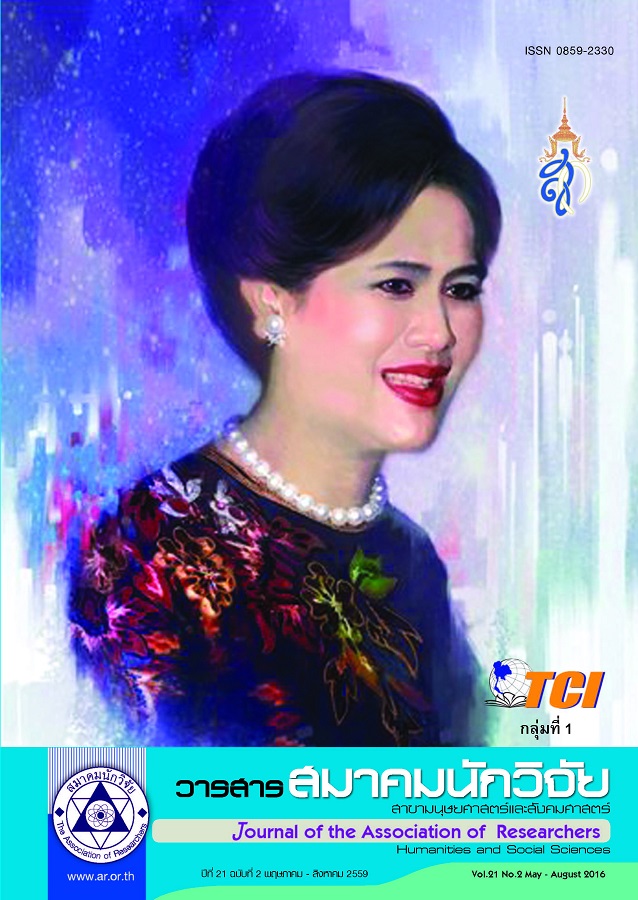Research Design for Mixed Method Research
Main Article Content
Abstract
Research design for mixed method research can be characterized as a mixture between quantitative and qualitative research. In this article, the mixed method research is separated into two approaches which are 1) Convergent-parallel approach 2) Exploratory-sequential approach. Moreover, researchers using the mixed method need to completely clarify research objective(s), procedural processes, and detailed descriptions of the selected research methodology which are accomplished by applying four designing criteria 1) weighting 2) timing 3) theorizing and 4) mixing. Advantages of the mixed method research are to help the researchers get new findings for knowledge acquisition and understanding studied aspects extensively and deeply in more accordance with the reality of social or educational sciences than using either of the two research methods. However, there are some limitations for using the mixed method research such as practical difficulty for conducting research due to researchers themselves being acquainted with and exclusively coached for only one of the two research methods; and, consequently, consuming much time and budget when doing research by means of the mixed method as well as not being capable of utilizing or even making the readers comprehend research results and findings. Nevertheless, since the late 20th decade, there have existed many research designs tending to use the mixed method in order to find answers to much more multi-dimensionally sophisticated research questions.
Article Details
บทความที่ปรากฏในวารสารนี้ เป็นความรับผิดชอบของผู้เขียน ซึ่งสมาคมนักวิจัยไม่จำเป็นต้องเห็นด้วยเสมอไป การนำเสนอผลงานวิจัยและบทความในวารสารนี้ไปเผยแพร่สามารถกระทำได้ โดยระบุแหล่งอ้างอิงจาก "วารสารสมาคมนักวิจัย"
References
ภัทราวดี มากมี. (2559ก). การพัฒนาโมเดลการวัดประสิทธิผลองค์การภาครัฐในเขตอาเซียน: การวิเคราะห์โมเดลสมการ โครงสร้างพหุระดับ. วารสารสมาคมนักวิจัย. 21(1), 34 -48.
ภัทราวดี มากมี. (2559ข). การประเมินผลกระทบของผู้มีส่วนได้ส่วนเสีย กรณีปัญหาน้ำมันดิบรั่วไหล จังหวัดระยอง: การวิจัยแบบผสานวิธี. วารสารมหาวิทยาลัยศิลปากร ฉบับภาษาไทย สาขาสังคมศาสตร์ มนุษยศาสตร์ และ ศิลปะ. 36(3).
References
Christensen, L. B., Johnson, R. B., & Turner, L. A. (2014). Research Methods, Design, and Analysis 11sted, Pearson Education, Inc., publishing as Allyn& Bacon.
Creswell, J.W. (2009). Research Design: Qualitative, Quantitative, and Mixed Methods Approaches 3rd ed. California: Sage.
Edmonds, W. A., & Kennedy, T. D. (2013). An Applied Reference Guide to Research Designs: Quantitative, Qualitative, and Mixed Methods, London: Sage.
Gravetter, F. J., &Forzano, L. B. (2012). Research Methods for Behavioral Sciences. International 4thed: Nelson Education, Ltd.
Greene, J. C., Caracelli, V. J., & Graham, W. F. (1989). Toward a Conceptual Framework for Mixed-method Evaluation Designs. Educational Evaluation and Policy Analysis, Vol 11, No. 3, 255-274.
Makmee, Pattrawadee Phadasri, Wiriya &SeesamaiDouangmany. (2015). factors affecting creative thinking in primary students as perceived by teachers. Journal of RangsitUniversity : Teaching & Learning.9(2), 20 – 32. (in Thai)
Makmee, Pattrawadee. (2016a). Development of A Model of Public Organizational Effectiveness Measurement in ASEAN: Multilevel Structural Equation Model Analysis. Journal of the Association of Researchers. 21(1), 34-48. (in Thai)
Makmee, Pattrawadee. (2016b). Impact Evaluation of Stakeholder of CrudeSpill Problem in Rayong Province: Mixed Method Research. Silpakorn University Journal of Social Sciences, Humanities, and Arts.36(3).(in Thai)
Mcmillan, J. H., & Schumacher, S. (2010). Research in Education.International 3rded: Pearson Education, Inc.
Teddlie, C., &Tashakkori, A. (2010) “Overview of contemporary issues in mixed methods research”, in Sage Handbook of Mixed Methods in Social & Behavioral Research, Tashakkori, A. and Teddlie, C. (Eds) 2010, Sage, California, 1


